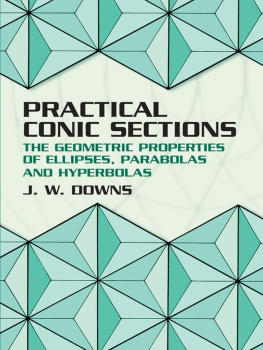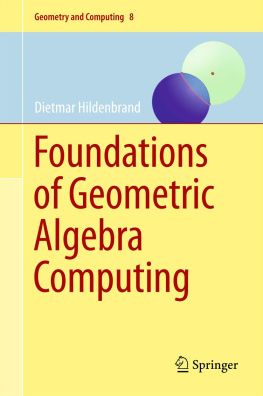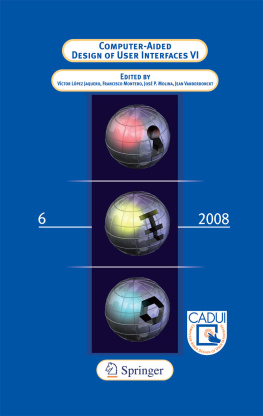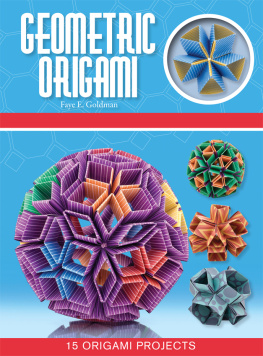


Ruiz, Oscar
Geometric functions in computer aided geometric design / Oscar Ruiz, Carlos Cadavid. -- Medelln : Fondo Editorial
Universidad EAFIT, 2008.
140 p. : il. ; 24 cm. -- (Coleccin acadmica)
ISBN 978-958-720-016-4
1. Diseo con ayuda de computador 2. Geometra con ayuda de computador 3. Grficos por computador 4. Ingeniera de diseo I. Cadavid, Carlos, 1955- II. Tt. III. Serie. 620.00420285 cd 21 ed.
A1184811
CEP-Banco de la Repblica-Biblioteca Luis ngel Arango
GEOMETRIC FUNCTIONS IN COMPUTER AIDED GEOMETRIC DESIGN
Primera edicin: septiembre de 2008
Primera reimpresin: mayo de 2010
scar Ruiz
Carlos Cadavid
Fondo Editorial Universidad EAFIT
Cra.49 No. 7 sur-50
www.eafit.edu.co/fondoeditorial
Email:
ISBN: 978-958-720-016-4
Imagen de cartula:
COVER
Aphrodites mesh was ray-traced using a simulated screen shaped into a helicoid tape embedded in a 3D ellipsoid. Prof. Dr. Eng. Oscar Ruiz and undergraduate assistants Carlos Vanegas and Ricardo Serrano. CAD CAM CAE Laboratory, EAFIT University, 2006-2007.
Editado en Medelln, Colombia
Diseo epub:
Hipertexto Netizen Digital Solutions
Contents
There are plenty of books that treat the topic of Computer Aided Geometric Design and Applications. These books usually have either one of two extreme approaches: purely operative and purely mathematical. The present book intends to fill this gap, by discussing important underlying mathematical facts and terminology of Computer Aided Geometric Design, while at the same time giving the reader a direct insight in the practical consequences of such facts and terms.
The overall content of the undergraduate courses Introduction to CAD CAM Systems, Introduction to Computer Aided Geometric Design or equivalent spans (i) Geometric Transformations, (ii) Parametric Curves and Surfaces, and (iii) Geometric and Solid Modeling. The present book deals with Geometric Transformations. The authors found that a previous material by them () presents the three topics in a very practical manner, leaving aside mathematical foundations that may be useful for the educated CAGD developer. The present book intends to represent such a deeper view, in the specific realm of Geometric Transformations.
The term Geometric Transformations is widely used in the practice of Computer Aided Geometric Design and Manufacturing. However, it is, formally, incorrect, since the material covers functions that are not transformations in the mathematical sense. They are not bijections. But they are useful, and necessary (an example are projections). The authors do not intend to solve a very ancient terminology issue. Therefore, they simply go along with the term, and write about Geometric Transformations referring to rotations, translations, perspectives, shears, affine, etc.
The material included in these notes corresponds to the lectures of the course IM024, Introduction to CAD CAM Systems, delivered by Profs. Oscar Ruiz and Carlos Cadavid in EAFIT University in the period 1996-2008. The exercises were assigned by Profs. Ruiz and Cadavid, and its solution and documentation supervised by them, as appears in the original manuscripts. At the end of the book a list of undergraduate students is given, who carried out such academic and editorial work under the supervision of Profs. Ruiz and Cadavid.
deals with non rigid transformations, such as parallel and perspective projections.
The reproduction of this material is forbidden without the express written consent of the authors and their sponsoring institutions.
Given two sets, X and Y, a function f is a binary relation f = {(x1, y1), (x2, y2), ..., (xn, yn), ...} such that if (x, y) f and (x, w) f then y = w. That is, to each element in X corresponds one and only one element in Y. The couple (xi, yi) is noted as yi = f(xi), and we say that the function f goes from X into Y, and denote this fact as f : X Y. If f : X Y, then Df = A = {x1, x2, ..., xn, ...} X is the domain or the set of all first components of f. The image or range of f, Rf = B = {y1, y2, ..., yn, ...} Y is the set of all second components of f. X is called the departure set of f and Y is called the codomain of f.
A function f : X Y is said:
Injective: if x1, x2X, x1x2 one has that f(x1) f(x2).
Onto: if y Yx X, such that f(x) = y.
Bijective: if f is injective and onto. When f : X Y is bijective, there exists f1 : Y X defined by f1(y) = x, since f(x) = y.
Given two functions f : X Y and g : Y Z such that Rf Dg, one defines the function gf : X Z as (gf)(x) = g(f(x)). The function gf is called the composition of g with f. Observe that the composition is not commutative. In particular, fg. will not exist unless Rg Df.
2.1.2.1 Properties of the function Composition
Existence: Given an x Df, the operation (gf)(x) is well defined since y = f(x) Rf also satisfies that y Dg and therefore g(y) = g(f(x)) exists.
Uniqueness: For all x Df the value (gf)(x) = g(f(x)) is unique since f and g are functions. Therefore, (gf)(x) = g(f(x)) is also a function.
Associativity: If holds that (h g f)(x) = h(g(f(x))) = ((h g) f)(x) = (h (gf))(x)
Let  be a function taking two operants:
be a function taking two operants:  (a, b) = a
(a, b) = a  b. There are two types of binary operations:
b. There are two types of binary operations:
Internal binary operation:  : A A A
: A A A
External binary operation:  : A B A
: A B A
An example of internal binary operator is the matrix multiplication, since the multiplication of two matrices results in a matrix. An example of external binary operator is the scalar multiplication between a real number and a matrix, giving as a result another matrix. In the following discussion, the reader must be able to distinguish when it deals with internal or external binary operators. In either case, we will talk simply of
Next page
















 be a function taking two operants:
be a function taking two operants: